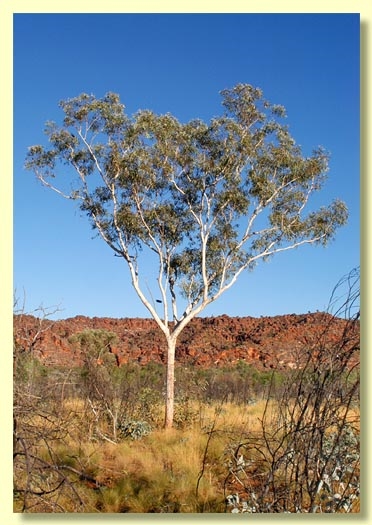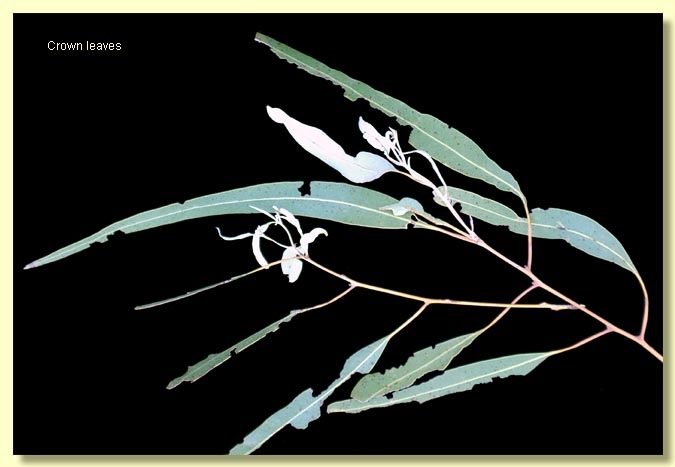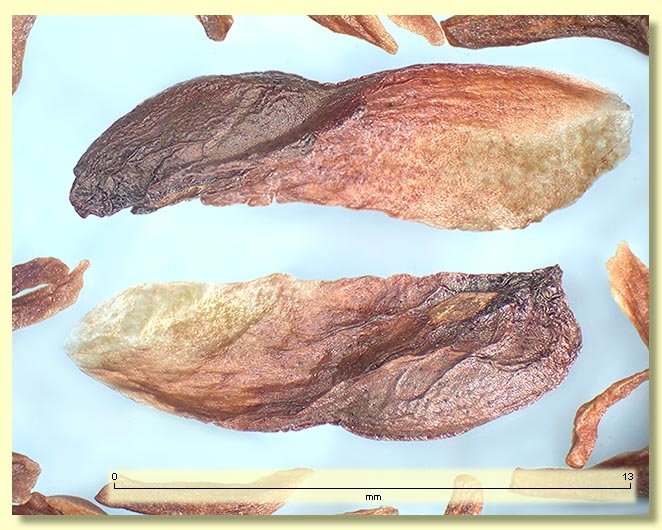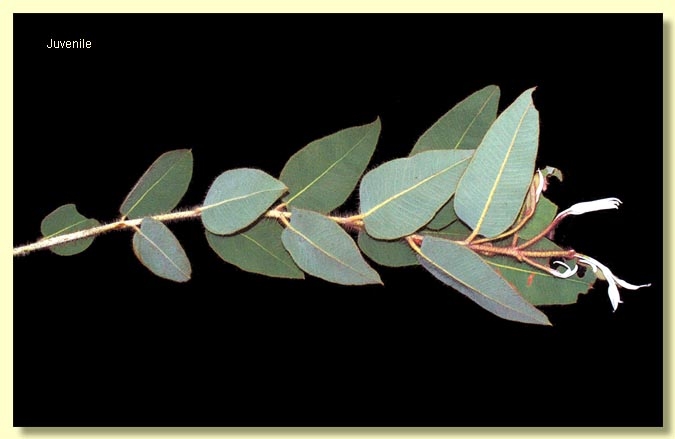Euclid - Online edition
Corymbia collina
Corymbia | Rufaria
Corymbia collina (W.V.Fitzg.) K.D.Hill & L.A.S.Johnson, Telopea 6: 290 (1995).
Eucalyptus collina W.V.Fitzg. in J.H. Maiden, Crit. Revis. Eucalyptus 4: 209 (1919). T: Western Australia: summit of Bold Bluff, May. 1905, W.V.Fitzgerald 844; holo: NSW; iso: BRI, E, PERTH.
E. macropoda Blakely, Key Eucalypts 87 (1934). T: Packhorse range, West Kimberleys, W.V.Fitzgerald, no. 1012, May 1905; holo: NSW; iso: PERTH.
Tree 10 m tall. Forming a lignotuber.
Bark thin, rough, patchy, fibrous-flaky to tessellated, variably extending over the base to all of trunk, but predominantly smooth, slightly powdery or not, white to cream or pale grey.
Branchlets lack oil glands in the pith; often whitish, especially new growth in crown, due to the rubbery cuticle, smooth.
Juvenile growth (coppice or field seedlings to 50 cm): stems rounded to square in cross-section, setose with bristle-glands to ca 3 mm long and with sparse microscopic white simple hairs also; juvenile leaves always shortly petiolate, opposite for many nodes, cordate to ovate, 5.5–13(17.7) cm long, 4–7(8.5) cm wide, base lobed to rounded, rarely peltate, apex rounded and apiculate or broadly pointed, green, with sparse bristle-glands and white simple hairs densely distributed on both surfaces, the density decreasing up the stem; by ca 0.8 m tall stems and leaves suddenly become glabrous and also whitish due to rubbery cuticle.
Crown of adult leaves with new growth distinctly silver-white, conspicuous from a distance.
Adult leaves alternate, petioles 1–3.7 cm long; blade lanceolate to falcate, 9.2–23.5 cm long, 1–3 cm wide, base tapering to petiole, margin entire, apex pointed, concolorous or only slightly discolorous, maturing glossy, green, smooth, side-veins greater than 45° to midrib, reticulation very dense, intramarginal vein not visible (contiguous with margin) or only just visible, oil glands present, island.
Inflorescence terminal compound, peduncles stout, 0.5–3.5 cm long, buds 7 per umbel, stoutly pedicellate (pedicels 0.5–2.8 cm long). Mature buds ovoid (1.3–1.6 cm long, 1–1.1 cm wide), smooth, often appearing whitish, scar absent (both opercula shed together at flowering), operculum rounded to bluntly conical, stamens inflexed, all fertile, anthers oblong, dorsifixed, versatile, dehiscing by longitudinal slits, style long and straight, stigma blunt and papillose, locules 4, the placentae each with indistinct ovule rows, the cluster moderately large. Flowers creamy white.
Fruit pedicellate (pedicels 0.5–3.5 cm long), thick-walled, barrel-shaped and not or only slightly contracted to form a neck, the rim not flared, 2.6–3.7 cm long, 1.8–2.5 cm wide, longer than wide, smooth, disc descending vertically, valves 4, enclosed.
Seeds brown, 9–13 mm long, ellipsoidal with terminal wing, hilum ventral.
Cultivated seedlings (measured at ca node 10): cotyledons reniform; stems rounded in cross-section, setose with bristle-glands and also with short white simple hairs on the epidermis; leaves always petiolate, opposite for at least 13 nodes, ovate to cordate, 5–10.5 cm long, 2–5 cm wide, base rounded on lower leaves, lobed higher up stem, dull, green, sparsely setose, and with a carpet of short white simple hairs on both surfaces.
Flowering has been recorded in April, May and June.
A bloodwood tree restricted to King Leopold Range, Phillips Range, Durack Range and Bungle Bungles area of the Kimberley region of Western Australia, preferring sandstone plateaus and ridges, though sometimes also on deeper sands. Corymbia collina has patches of thin flaky-fibrous bark on the otherwise smooth white trunk, a green glossy crown with silvery white new growth in season, elongated buds and barrel-shaped fruit 2.6–3.7 cm long, 1.8–2.5 cm wide. The juvenile leaves are setose and hairy until ca 0.8 m tall when abruptly become glabrous and show a distinctive white "rubbery" surface.
C. collina is a distinctive species unlikely to be confused with any other bloodwood if new shoot growth is present; it is closely related to and resembles C. bleeseri, which lacks the white new growth and has smaller barrel-shaped fruit. C. collina has much larger fruit than the widespread C. dichromphloia which, in its Kimberley populations, may have similar whitish new adult leaf growth but has much smaller urn-shaped fruit and small, more rounded buds. The two species occur near each other in the Phillips Range with C. collina preferring the hilltops and C. dichromophloia the steep rocky northern slopes.
MORE ABOUT CORYMBIA
MORE ABOUT RED BLOODWOODS
Corymbia collina: Latin collinus, located on a hill, referring to the habitat.















